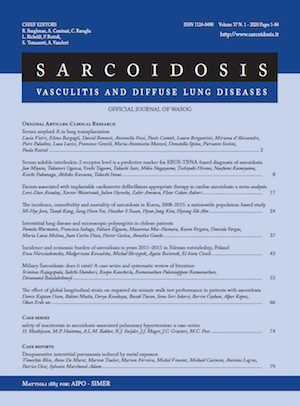The effect of global longitudinal strain on ımpaired six-minute walk test performance in patients with sarcoidosis Subclinical Cardiac Sarcoidosis effects on walking distance
Main Article Content
Keywords
global longitudinal strain, sarcoidosis, six-minutes walk test, two-dimensional speckle tracking echocardiography, pulmonary hypertension
Abstract
Background: Sarcoidosis is a multisystem and granulomatous disease associated with impaired functional capacity as a result of pulmonary and cardiac involvement. Factors adversely effecting functional capacity in patients with sarcoidosis have not been systematically assessed including myocardial strain imaging on echocardiography which enable to diagnose subclinical cardiac dysfunction. We aimed to evaluate the effect of left and right ventricular global longitudinal strain (GLS) on submaximal exercise capacity in patients with sarcoidosis who do not have clinically manifest cardiac involvement. Methods: Extracardiac biopsy proven 56 patients with sarcoidosis and 26 controls were included consecutively. Submaximal exercise capacity of the subjects was assessed with six-minute walk test (6 MWT). Pulmonary function tests and standard transthoracic and two-dimensional speckle tracking echocardiography were performed to the all subjects. Linear regression analysis was performed to find independent predictors of 6 MWT. Results: Fifty-six patients (18% male) with a mean age of 52.5 ± 10.7 years were included. Patients with sarcoidosis had low 6 MWT performance and higher New York Heart Association classes and NT-proBNP levels. There were no significant differences between controls and patients with sarcoidosis in parameters of pulmonary function test. Biventricular GLS levels and biatrial reservoir and conduit function values were lower and systolic pulmonary artery pressure (SPAP) was significantly higher in patients with sarcoidosis as compared with controls. Older age and higher SPAP were found as independent predictors of poor 6 MWT performance. Conclusion: Although biventricular GLS levels were lower in the patients with sarcoidosis, only age and SPAP elevations were independent predictors of the submaximal exercise capacity.






